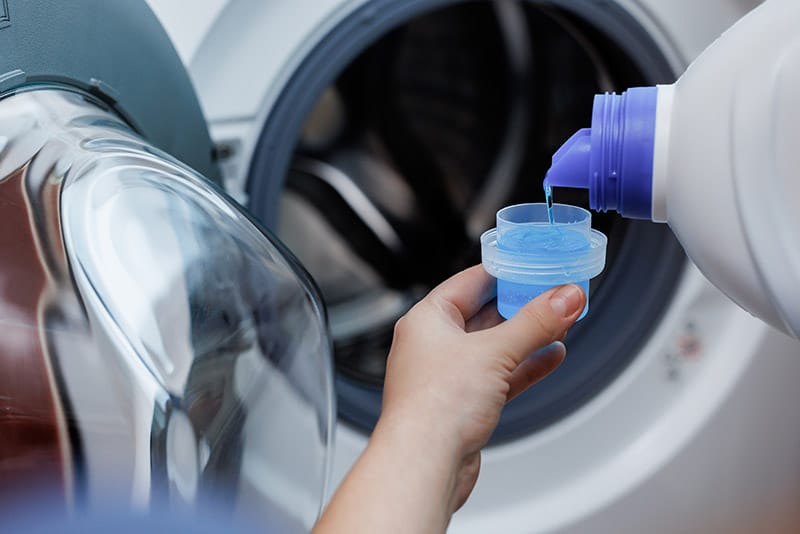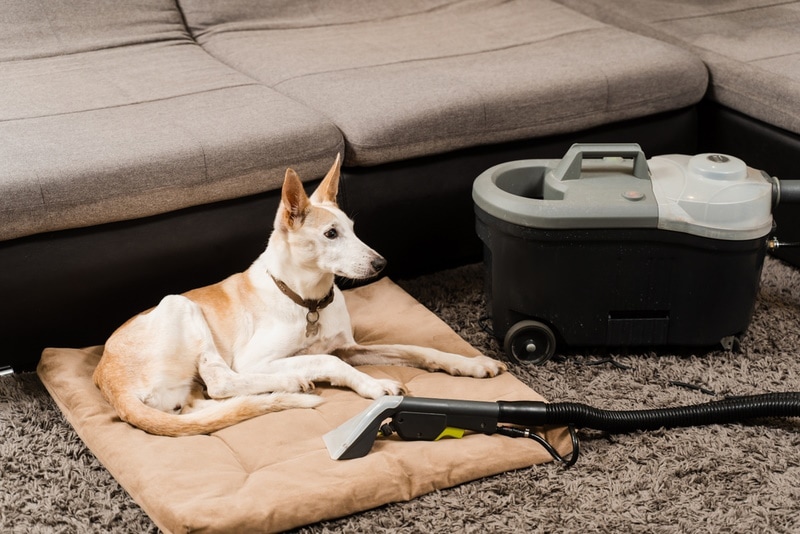Dogs can get messy really quickly. They’re close to ground level so when they walk through puddles or in dusty environments, the muck gets kicked up and transfers to their fur. And lots of dogs love to swim in rivers, roll in puddles, or even fox poop. And then there’s the dogs that dribble urine or get bits of poop stuck to their rear end. In all these cases, it is the dog bed that really suffers.
For some dog beds, it doesn’t take long before they start to stink. And it is a perpetuating cycle. If your dog sleeps in a smelly bed, the smell transfers to them, and it becomes increasingly difficult to shift that bad dog smell. It is a good idea to wash your dog’s bed whenever you wash your dog, and you should wash it every few weeks to keep on top of the bad smells.
Below, we look at the main steps to help you clean your dog’s bed, whether it’s a solid bed, a memory foam mattress, or a soft pillowy bed with a removable cover.

The 9 Steps to Cleaning a Dog Bed
1. Get Rid of the Hair by Vacuuming

Putting a cover or blanket covered in dog hair through the wash means that the hair will clump up and can potentially get stuck in the washing machine. It is certainly very difficult to properly clean.
Whether the bed has a removable cover or not, start by vacuuming any hair off the outside using a pet hair attachment on your vacuum.
2. Remove Stains
If there are stains on the bedding, you should try and remove them before giving it a general wash. Pay particular attention to urine and poop stains. In the case they are present, using an enzymatic cleaner specific to these pet stains will be most effective. You may need to use additional pet-safe cleaning products or perform multiple washes.
No matter how hard you try, pets will always leave you cleaning up smells, stains, vomit, hair, and everything in between. With the Hepper Advanced Bio-Enzyme Pet Stain & Odor Eliminator Spray, you can advance your clean-up routine!
It permanently removes the very worst pet stains and smells (and truly makes clean-up a breeze). Click here to learn more, order a bottle, and freshen up your home today. At Dogster, we’ve admired Hepper for many years, and decided to take a controlling ownership interest so that we could benefit from the outstanding products of this cool pet company!
3. Remove Covers

If the cover comes off, remove it. This will enable you to clean the cover more effectively and it will also enable you to see what lurks beneath the cover. If you only clean the outside of the bed and there’s a mess on the inside, this will transfer to the cover, and you will be in the same position even after cleaning.
4. Cleaning a Handwash-Only Bed
If the cover cannot be removed, you will likely need to clean the whole bed in one go. For handwash beds, fill a bath with water, add a suitable detergent, and let it dissolve fully. Put the bed in the water, trying to ensure it is fully submerged, and leave it for a quarter of an hour.
5. Use the Washing Machine

Remove the cover from the bed and place it in the washing machine, use a hot water setting, and use a non-toxic detergent. Even if the mattress or inner can be machine washed, if it is too big for your machine, or too heavy, do not put it in the washing machine.
You might be able to find a machine with a bigger weight limit at a local launderette. If you can fit the mattress in your machine, use a hot water setting and the same non-toxic detergent you used on the outer cover.
6. Cleaning Memory Foam
Cleaning a memory foam mattress takes a little more work. Follow the manufacturer’s instructions, ideally. Another option: create a spray using non-toxic laundry detergent mixed with water and spray the solution onto the bed so that it is covered but not soaking wet. Cover with baking soda and leave the bed overnight.
Once dry, vacuum the bed again. You will have to do both sides of the mattress individually.
7. Cleaning a Hard Bed

Hard beds can be easier to clean, and you should be able to get most of the dirt and mess off using a damp, soapy cloth. You should vacuum the bed still and if there are difficult stains, you may have to work the area a little harder.
8. Leave It to Dry
Whatever the type of bed and method you used to wash it, leave the bed to dry. Ideally, you should dry the bed naturally, leaving it outside if weather permits. This will help remove any final smells and air the bedding naturally.
Failing this, hang it somewhere inside and leave it until it is completely dry before using it again.
9. Reconstruct the Bed

Once everything is dry, put it all back together and let your dog have its bed. Follow instructions or reverse the steps you took to take the bed apart and ensure that it is comfortable and that the filling is evenly spread.

Is it Okay to Wash a Dog Bed in the Washing Machine?
It really depends on the bed and bedding your dog has. Check the label and any manufacturer’s instructions and follow the recommended guidelines. Some beds need to be hand washed, but many can be put in the washing machine. This even includes the bed inner.
How Often Do You Wash a Dog Bed?
It is a good idea to get into the habit of washing a dog bed every couple of weeks. This helps control odors and also ensures that your dog doesn’t get ill from any bacteria or mess on the bed.

How Do You Clean the Stuffing in a Dog Bed?
If the bed has a solid foam insert, it will need hand washing. If it has polyester or fiberfill filling, it should be possible to put it in the washing machine, but you should check the washing guidelines first or you risk damaging the bed.
Some beds can be put in the washing machine without having to remove the cover, but if the cover can be removed, it is generally better to clean the cover and the filling separately for the best results and to help prevent damage.
What If the Bed Is Infested With Fleas?
Dogs spend a lot of time on their beds, and this can cause fleas to get on the bedding. If a bed is infested with fleas, one easy option is to throw it out and get a new one. Otherwise, a thorough cleaning as above, can be pursued. Ensure hot water is used during the cleaning cycle. Cocoons may still remain on the bed, however, and nothing can kill them. Therefore, ensuring that all household pets are on appropriate, veterinary prescribed flea treatment, is crucial.
If you need to speak with a vet but can't get to one, head over to PangoVet. It's our online service where you can talk to a vet online and get the advice you need for your dog — all at an affordable price!

Final Thoughts
Some dogs seem to have a habit of getting really messy and transferring this to their bed. But, even if your dog isn’t a messy pup, their bed will still need regular washing. The bed should have clear instructions on how to wash. This may mean removing the cover and washing the components separately, and some beds have to be hand-washed, rather than machine-washed.
Vacuum first to remove hair, wash according to the guidelines, and then let the bed dry naturally, before putting it back together. If you do notice fleas during cleaning, it is a sign that it’s time to throw the bed out and get a new one.
Featured Image Credit: Rabizo Anatolii, Shutterstock




















